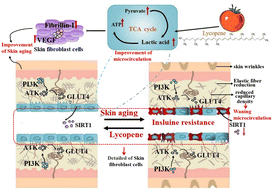Lycopene ameliorates skin aging by regulating the insulin resistance pathway and activating SIRT1†
Abstract
Microvascular loss is one of the most important characteristics of skin aging and several microvascular activities play key roles in preserving skin health. In vitro, lycopene (Ly) reduced the contents of reactive oxygen species (ROS), β-galactosidase, and advanced glycosylation end products (AGEs), while increasing the contents of ATP and NAD+/NADH along with the mitochondrial membrane potential (MMP). Furthermore, the expression of Fibrillin-I and VEGF was increased in aged primary skin fibroblast cells (PRSFs). LC-MS non-targeted cell metabolomics demonstrated a mechanism by which (Ly) lycopene protects aging skin cells, and the KEGG analysis predicted the pathways involved. In vivo, aged rats exhibited signs of reduced capillary density and blood flow, skin aging, mitochondrial disorder, and insulin resistance. Following Ly intervention, these phenomena were reversed. Meanwhile, insulin pathway protein, VEGF, and SIRT1 protein expression data showed that lycopene might reverse insulin resistance and promote microvascular renewal to protect aging skin. In summary, all data demonstrated that Ly might reverse insulin resistance via SIRT1 during skin aging and promote microvascular neovascularization to protect aging skin.



 Please wait while we load your content...
Please wait while we load your content...